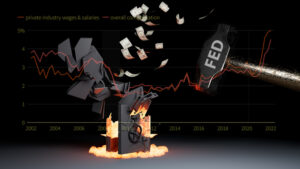Gold Is Best Place to Be, S&P The Worst as Fed Hikes
The comments below are an edited and abridged synopsis of an article by Ven Ram
Gold is the most resilient asset to own if the Fed continues to raise rates, while stocks are the worst place to be. Non-dollar currencies fall between the two.
Gold has had an empirical duration of just over 3 years in the current Fed cycle, compared with stocks at 7.1 years. The non-dollar currencies that make up the G-10 have seen a duration of 5.3 years.
Duration measures the percentage change of an asset in reaction to a 1 percentage point shift in interest rates. Gold is the least sensitive to Fed moves.
Gold’s low was around $1,615 for this cycle, a 12% decline since the start of the year that stemmed from the Fed raising its benchmark interest rate by 300 basis points, with another 75 basis points priced in from the latest policy review.
Other G-10 currencies have seen an average duration of 5.3 years in the current cycle, highlighting their sensitivity to any perceptible shift in interest rate differentials.
Still, stocks are the most sensitive to shifts in the Fed’s benchmark, with the S&P 500 demonstrating a duration of 7.1 years and the Nasdaq about 9.6 years.
The sensitivity of stocks is in contrast to prior Fed cycles. The heightened duration in this cycle is a reflection of how low earnings’ yields on stocks had fallen before the Fed started raising rates.
Gold’s relative resilience echoes a study from 2020 that showed the metal had a good degree of convexity. In essence, gold stands to lose less when interest rates rise, and gain more when rates fall by the same amount.
While the estimated duration then was 17, that measure has clearly fallen even more in this cycle, accentuating the effects of convexity.
Among currencies, the yen, the Nordic complex and sterling have been the most vulnerable to the Fed’s rate increases, as the chart included shows.

